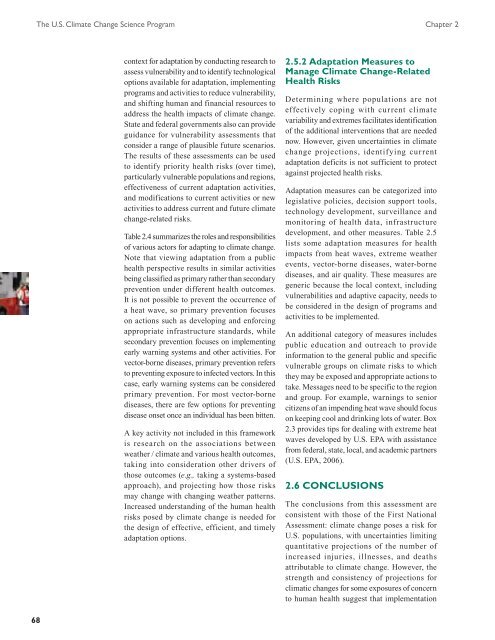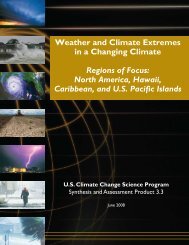Analyses of the Effects of Global Change on - US Climate Change ...
Analyses of the Effects of Global Change on - US Climate Change ...
Analyses of the Effects of Global Change on - US Climate Change ...
Create successful ePaper yourself
Turn your PDF publications into a flip-book with our unique Google optimized e-Paper software.
The U.S. <strong>Climate</strong> <str<strong>on</strong>g>Change</str<strong>on</strong>g> Science Program Chapter 2<br />
68<br />
c<strong>on</strong>text for adaptati<strong>on</strong> by c<strong>on</strong>ducting research to<br />
assess vulnerability and to identify technological<br />
opti<strong>on</strong>s available for adaptati<strong>on</strong>, implementing<br />
programs and activities to reduce vulnerability,<br />
and shifting human and financial resources to<br />
address <str<strong>on</strong>g>the</str<strong>on</strong>g> health impacts <str<strong>on</strong>g>of</str<strong>on</strong>g> climate change.<br />
State and federal governments also can provide<br />
guidance for vulnerability assessments that<br />
c<strong>on</strong>sider a range <str<strong>on</strong>g>of</str<strong>on</strong>g> plausible future scenarios.<br />
The results <str<strong>on</strong>g>of</str<strong>on</strong>g> <str<strong>on</strong>g>the</str<strong>on</strong>g>se assessments can be used<br />
to identify priority health risks (over time),<br />
particularly vulnerable populati<strong>on</strong>s and regi<strong>on</strong>s,<br />
effectiveness <str<strong>on</strong>g>of</str<strong>on</strong>g> current adaptati<strong>on</strong> activities,<br />
and modificati<strong>on</strong>s to current activities or new<br />
activities to address current and future climate<br />
change-related risks.<br />
Table 2.4 summarizes <str<strong>on</strong>g>the</str<strong>on</strong>g> roles and resp<strong>on</strong>sibilities<br />
<str<strong>on</strong>g>of</str<strong>on</strong>g> various actors for adapting to climate change.<br />
Note that viewing adaptati<strong>on</strong> from a public<br />
health perspective results in similar activities<br />
being classified as primary ra<str<strong>on</strong>g>the</str<strong>on</strong>g>r than sec<strong>on</strong>dary<br />
preventi<strong>on</strong> under different health outcomes.<br />
It is not possible to prevent <str<strong>on</strong>g>the</str<strong>on</strong>g> occurrence <str<strong>on</strong>g>of</str<strong>on</strong>g><br />
a heat wave, so primary preventi<strong>on</strong> focuses<br />
<strong>on</strong> acti<strong>on</strong>s such as developing and enforcing<br />
appropriate infrastructure standards, while<br />
sec<strong>on</strong>dary preventi<strong>on</strong> focuses <strong>on</strong> implementing<br />
early warning systems and o<str<strong>on</strong>g>the</str<strong>on</strong>g>r activities. For<br />
vector-borne diseases, primary preventi<strong>on</strong> refers<br />
to preventing exposure to infected vectors. In this<br />
case, early warning systems can be c<strong>on</strong>sidered<br />
primary preventi<strong>on</strong>. For most vector-borne<br />
diseases, <str<strong>on</strong>g>the</str<strong>on</strong>g>re are few opti<strong>on</strong>s for preventing<br />
disease <strong>on</strong>set <strong>on</strong>ce an individual has been bitten.<br />
A key activity not included in this framework<br />
is research <strong>on</strong> <str<strong>on</strong>g>the</str<strong>on</strong>g> associati<strong>on</strong>s between<br />
wea<str<strong>on</strong>g>the</str<strong>on</strong>g>r / climate and various health outcomes,<br />
taking into c<strong>on</strong>siderati<strong>on</strong> o<str<strong>on</strong>g>the</str<strong>on</strong>g>r drivers <str<strong>on</strong>g>of</str<strong>on</strong>g><br />
those outcomes (e.g., taking a systems-based<br />
approach), and projecting how those risks<br />
may change with changing wea<str<strong>on</strong>g>the</str<strong>on</strong>g>r patterns.<br />
Increased understanding <str<strong>on</strong>g>of</str<strong>on</strong>g> <str<strong>on</strong>g>the</str<strong>on</strong>g> human health<br />
risks posed by climate change is needed for<br />
<str<strong>on</strong>g>the</str<strong>on</strong>g> design <str<strong>on</strong>g>of</str<strong>on</strong>g> effective, efficient, and timely<br />
adaptati<strong>on</strong> opti<strong>on</strong>s.<br />
2.5.2 Adaptati<strong>on</strong> Measures to<br />
Manage <strong>Climate</strong> <str<strong>on</strong>g>Change</str<strong>on</strong>g>-Related<br />
Health Risks<br />
Determining where populati<strong>on</strong>s are not<br />
effectively coping with current climate<br />
variability and extremes facilitates identificati<strong>on</strong><br />
<str<strong>on</strong>g>of</str<strong>on</strong>g> <str<strong>on</strong>g>the</str<strong>on</strong>g> additi<strong>on</strong>al interventi<strong>on</strong>s that are needed<br />
now. However, given uncertainties in climate<br />
change projecti<strong>on</strong>s, identifying current<br />
adaptati<strong>on</strong> deficits is not sufficient to protect<br />
against projected health risks.<br />
Adaptati<strong>on</strong> measures can be categorized into<br />
legislative policies, decisi<strong>on</strong> support tools,<br />
technology development, surveillance and<br />
m<strong>on</strong>itoring <str<strong>on</strong>g>of</str<strong>on</strong>g> health data, infrastructure<br />
development, and o<str<strong>on</strong>g>the</str<strong>on</strong>g>r measures. Table 2.5<br />
lists some adaptati<strong>on</strong> measures for health<br />
impacts from heat waves, extreme wea<str<strong>on</strong>g>the</str<strong>on</strong>g>r<br />
events, vector-borne diseases, water-borne<br />
diseases, and air quality. These measures are<br />
generic because <str<strong>on</strong>g>the</str<strong>on</strong>g> local c<strong>on</strong>text, including<br />
vulnerabilities and adaptive capacity, needs to<br />
be c<strong>on</strong>sidered in <str<strong>on</strong>g>the</str<strong>on</strong>g> design <str<strong>on</strong>g>of</str<strong>on</strong>g> programs and<br />
activities to be implemented.<br />
An additi<strong>on</strong>al category <str<strong>on</strong>g>of</str<strong>on</strong>g> measures includes<br />
public educati<strong>on</strong> and outreach to provide<br />
informati<strong>on</strong> to <str<strong>on</strong>g>the</str<strong>on</strong>g> general public and specific<br />
vulnerable groups <strong>on</strong> climate risks to which<br />
<str<strong>on</strong>g>the</str<strong>on</strong>g>y may be exposed and appropriate acti<strong>on</strong>s to<br />
take. Messages need to be specific to <str<strong>on</strong>g>the</str<strong>on</strong>g> regi<strong>on</strong><br />
and group. For example, warnings to senior<br />
citizens <str<strong>on</strong>g>of</str<strong>on</strong>g> an impending heat wave should focus<br />
<strong>on</strong> keeping cool and drinking lots <str<strong>on</strong>g>of</str<strong>on</strong>g> water. Box<br />
2.3 provides tips for dealing with extreme heat<br />
waves developed by U.S. EPA with assistance<br />
from federal, state, local, and academic partners<br />
(U.S. EPA, 2006).<br />
2.6 CONCL<strong>US</strong>IONS<br />
The c<strong>on</strong>clusi<strong>on</strong>s from this assessment are<br />
c<strong>on</strong>sistent with those <str<strong>on</strong>g>of</str<strong>on</strong>g> <str<strong>on</strong>g>the</str<strong>on</strong>g> First Nati<strong>on</strong>al<br />
Assessment: climate change poses a risk for<br />
U.S. populati<strong>on</strong>s, with uncertainties limiting<br />
quantitative projecti<strong>on</strong>s <str<strong>on</strong>g>of</str<strong>on</strong>g> <str<strong>on</strong>g>the</str<strong>on</strong>g> number <str<strong>on</strong>g>of</str<strong>on</strong>g><br />
increased injuries, illnesses, and deaths<br />
attributable to climate change. However, <str<strong>on</strong>g>the</str<strong>on</strong>g><br />
strength and c<strong>on</strong>sistency <str<strong>on</strong>g>of</str<strong>on</strong>g> projecti<strong>on</strong>s for<br />
climatic changes for some exposures <str<strong>on</strong>g>of</str<strong>on</strong>g> c<strong>on</strong>cern<br />
to human health suggest that implementati<strong>on</strong>




